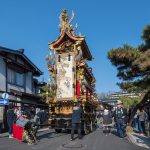Arimatsu, a town located in the Aichi Prefecture of Japan, is famous for its traditional craft of Shibori tie-dyeing. This technique has a rich history dating back over 400 years. Arimatsu was a key post town on the ancient Tokaido road, which connected Tokyo and Kyoto during the Edo period. The strategic location allowed the craft to thrive, as artisans could sell their goods to travelers passing through.
Shibori is a meticulous and artistic method of dyeing fabric. It involves binding, stitching, folding, twisting, or compressing the cloth to create different patterns. When the fabric is dyed, the areas protected by these methods resist the dye, resulting in unique, often intricate designs. The technique allows for a variety of patterns, from simple dots to complex images resembling natural scenes or abstract shapes.
Arimatsu’s Shibori technique is more than just a traditional craft; it’s a deeply ingrained cultural practice that has evolved over centuries. This form of textile art involves a variety of methods, each creating distinct patterns that are not only beautiful but also carry historical significance.
Techniques and Patterns
- Kumo Shibori – This method involves pleating sections of the cloth very finely and evenly. Then, it is bound in close sections, resulting in spider-like designs after dyeing.
- Kanoko Shibori – Often compared to the Western tie-dye, this technique produces small circles or dots that resemble fawn (kanoko) spots. It’s achieved by binding small sections of the fabric to achieve the desired patterns.
- Itajime Shibori – A shape-resist technique where the fabric is folded like an accordion, sandwiched between two pieces of wood, which are then bound together. This method creates symmetrical, geometric patterns.
- Miura Shibori – A looped binding technique where a hooked needle is used to pluck sections of the cloth and a thread is then looped around each section. It’s one of the easier techniques and produces water-like patterns.
- Nui Shibori – This is a stitched shibori technique where a simple running stitch is used along with the fabric being gathered tightly together. The thread is not cut after dyeing, creating unique, diverse patterns.
Cultural and Economic Aspects
The town also hosts museums and workshops dedicated to Shibori, allowing visitors to learn about the history and technique, and even try their hand at making their own Shibori art. This interactive aspect helps promote and preserve the craft, making Arimatsu a significant cultural destination for those interested in traditional Japanese textiles.
The artisans of Arimatsu have mastered these techniques, passing down their skills from generation to generation, ensuring the survival and evolution of Shibori. Economically, Shibori played a significant role in the prosperity of Arimatsu. The town’s location on the Tokaido road meant that many travelers stopped there, providing a ready market for Shibori textiles which were highly prized for their quality and beauty.
Arimatsu Shibori is noted for its high quality and the depth of skill involved, which can be seen in the precision of the patterns and the vibrant colors used. The town not only preserves this ancient technique but also adapts it to modern fashion and decor, helping to sustain interest and relevance in traditional crafts.
The Arimatsu Shibori Festival is an annual event that celebrates the town’s rich heritage in Shibori, the traditional Japanese tie-dyeing technique. The festival typically takes place in early June, coinciding with the peak of the Shibori craft season. It draws both locals and tourists alike, providing a deep dive into the historical and cultural significance of this unique art form.
Arimatsu Narumi Shibori Festival
Shibori Workshops and Demonstrations
One of the main attractions of the festival is the array of workshops and live demonstrations where skilled artisans showcase the various Shibori techniques. Visitors can watch experts at work, see how the intricate patterns are created, and even try their hands at making their own Shibori creations.
Street Market
The streets of Arimatsu are lined with stalls selling a wide range of Shibori products, from traditional kimonos and scarves to modern accessories and home decor items. It’s an excellent opportunity for visitors to purchase authentic Shibori crafts directly from the artisans.
Exhibitions
The festival features exhibitions that display both historical and contemporary Shibori works. These exhibitions highlight the evolution of the Shibori techniques and their applications, showcasing everything from ancient patterns to modern fashion statements.
Parades and Cultural Performances
The festival also includes cultural parades, music, and dance performances that reflect the rich history of the region and its crafts. These events provide a festive atmosphere and offer insight into Japanese cultural traditions.
Food and Drink
No festival in Japan would be complete without delicious local cuisine. Food stalls at the festival offer traditional Japanese street food and regional specialties, allowing visitors to enjoy a taste of local flavors.
Educational and Cultural Impact
The Arimatsu Shibori Festival not only serves as a celebration of the Shibori craft but also plays a crucial role in educating the public about this traditional art. It helps preserve the techniques passed down through generations by involving the community and engaging with a wider audience. The festival emphasizes the importance of maintaining and evolving traditional crafts in the modern world, ensuring that they remain a living part of cultural heritage.
For anyone interested in Japanese culture, traditional arts, or textile crafts, the Arimatsu Shibori Festival is a compelling event that offers a rich, immersive experience.
Arimatsu Shibori Festival
June 3, 4, 2024
Arimatsu Village – Arimatsu-Narumi Tie-Dying Museum
More Info- shibori-fes.nagoya/en
052-261-0111
Asturio Cantabrio, CC BY-SA 4.0, via Wikimedia Commons





Hello,
I am planning on visiting Japan in 2025 and wondered if the dates for the 2025 Shibori festival has been set yet? Or approximate dates?
We would like to include the festival as part of our visit.
Best,
Jerilyn Larson